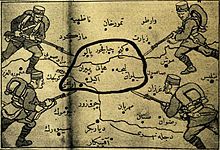Sheikh Said Uprising
The Sheikh Said Uprising ( Kurdish Serhildana Şêx Seîdê Pîranî , Turkish Şeyh Said İsyanı ) was an uprising in Turkey in 1925 under the leadership of Sheikh Said . The uprising was a reaction of several Kurdish tribal groups under the leadership of the strict Sunni order sheik against the secularization policy of the early Turkish Republic under Mustafa Kemal Pasha . The uprising was put down within a few weeks by the Turkish army.
prehistory
Preparations for the uprising began in 1924. In that year the religious institution of the caliphate was abolished by the National Assembly. The Kurdish language was also banned in public that year . The Azadi organization carried out intensive propaganda. After a mutiny by Kurds in the 7th Army Corps, large parts of the Azadi leadership were arrested. Sheikh Said took over the lead from then on.
Since the Turkish government wanted the local Kurdish people behind it on the Mosul issue , it was ready to grant them some of their demands that came close to autonomy . On August 1, 1924, a conference was held in Diyarbakır to determine the extent of the Kurds' rights. There they were promised a general amnesty , special payments from the budget, five years of tax exemption and the reintroduction of the Sharia courts. The representatives of the Kurdish population agreed and in return promised to support Turkey on the Mosul question. Before the agreement could be ratified in the Grand National Assembly of Turkey , however, the uprising broke out. Thus, the uprising played into the hands of the British, as Turkey on the one hand had to use its military capacity to end the uprising and thus a possible intervention in northern Iraq was impossible.
A mixture of Kurdish nationalism and Islamism triggered the Kurdish uprising under Sheikh Said. He also had contacts with many important Kurdish leaders of the time, such as Alişan from Koçgiri, Said Riza from Tunceli , Simko Schikak from East Kurdistan and Mahmud Barzandschi from Suleymania in Iraq .
course

The insurgents gradually conquered the surrounding cities. On February 17, 1925, the governor of Genç was captured in what is now Bingöl Province . Sheikh Said captured Genç, Maden and Siverek, and then moved towards Diyarbakır . Other units conquered Varto in the province of Mus and then moved to the city of Mus . Martial law was declared on February 23. Elazığ was captured on February 24th . A few days later, Sheikh Said's brother Ebdurrehîm took the city of Çermik and was reinforced by Sheikh Eyûb with men from the Siverek district. Together they conquered Ergani.
On February 25, the government enacted the "Law for the Consolidation of Order" ( Takrir-i Sükûn Kanunu ) with exceptional powers over the government. On February 27, the Turkish army launched air strikes and a major ground offensive; a total of 50,000 well-equipped Turkish soldiers were finally deployed. The uprising against the Turkish army could not last long due to the lack of heavy weapons. On April 27th, Sheikh Said and 47 fellow combatants were taken prisoner at his headquarters in Genç, sentenced to death by a Turkish independence court and hanged on September 4th . Thousands of less influential Kurds were killed without trial and the populations of entire districts were deported.
On the side of the Turkish state, three Alevi Kurdish tribes, the Xormek, Haydaran and Lolan, fought against the uprising. The background was old tribal rivalries with the Sunni tribe of the Cibran, who fought on the side of the rebels. These tribes prevented the capture of Erzincans and Erzurum .
After the uprising, thousands of Kurds were expelled to western Turkey . Small groups that managed to escape continued the fight as guerrillas . These activities continued until 1927.
literature
- Martin van Bruinessen : Agha, Sheikh and State - Politics and Society of Kurdistan . editionParabolis, Berlin 2003, ISBN 3-88402-259-8 (new edition).
- Yaşar Kalafat: Şark meselesi ışıgında Şeyh Sait olayı, karakteri, dönemindeki iç ve dış olaylar . In: Boğaziçi ilmî araştırmalar serisi; 11 . Boğaziçi Yayınları, Ankara 1992, ISBN 975-451-083-0 , p. 407 .
- Robert Olson: The Emergence of Kurdish Nationalism and the Sheikh Said Rebellion . University of Texas Press, Austin TX 1989, ISBN 978-0-292-77619-7 , pp. 229 .
Individual evidence
- ↑ Klaus Kreiser, Christoph Neumann A Little History of Turkey , 2009, p. 388
- ↑ Mim Kemal Öke: Belgelerle Türk-İngiliz ilişkilerinde Musul ve Kürdistan sorunu, from 1918 to 1926 . In: 123 . 1st edition. tape III , A-33. Türk Kültürünü Araştırma Enstitüsü, Ankara 1992, ISBN 975-456-052-8 , Beşinci Bölüm: Şeyh Sait İsyanı, Nesturiler ve Meselenin Devletlerarası Hakemliğe Havalesi, p. 159 (Turkish).
- ↑ Martin van Bruinessen: Agha, Sheikh and State . Berlin 1989, p. 415
- ↑ a b Martin van Bruinessen: Agha, Scheich and State Berlin 1989, p. 418
- ↑ Cf. Mehmet Şerif Fırat: Doğu İlleri ve Varto Tarihi. Ankara 1970 (reprint). There is also a letter from Sheikh Said to the Xormek leaders.
- ↑ Martin van Bruinessen: Agha, Scheich and State Berlin 1989, p. 411
- ↑ Martin Strohmeier, Lale Yalçin-Heckmann: The Kurds. History, politics, culture. Beck Verlag, Munich 2003, p. 97